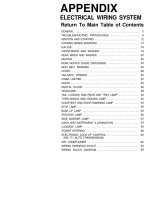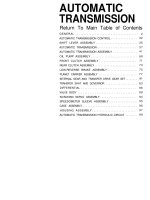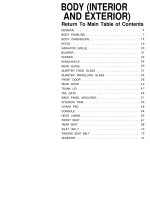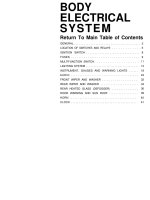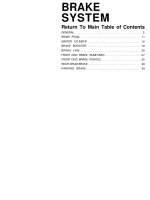Xe ô tô hyundai excel toàn tập hyundai excel - P8
Bạn đang xem bản rút gọn của tài liệu. Xem và tải ngay bản đầy đủ của tài liệu tại đây (275.76 KB, 18 trang )
COOLING
SYSTEM
Return To Main Table of Contents
GENERAL
. . . . . . . . . . . . . . . . . . . . . . . . . . . . . . . . . . . . .
2
COOLING SYSTEM
.................................
9
RADIATOR
...........................................
11
RADIATOR CAP ........................................
13
WATER PUMP ......................................
14
THERMOSTAT
.......................................
16
WATER TEMPERATURE GAUGE UNIT
...................17
WATER CUT VALVE .................................. 18
GENERAL
GENERAL
SPECIFICATIONS
Cooling method
Cooling system
Quantity
Radiator
Type
Performance
Radiator cap
Main valve opening pressure
Vacuum valve opening pressure
Water pump
Thermostat
Type
Valve opening temperature
Full-opening temperature
Valve lift, fully open
Identification mark
Drive belt
Type
Water temperature gauge unit
Type
Resistance
Water temperature sensor (for vehicles with automatic
transmission
Type
Switching temperature
Automatic transmission oil cooler
Quantity
Performance
Water-cooled, pressurized,
Forced circulation with electrical fan
5.0 lit (5.3 U.S.qts., 4.4 Imp.qts.)
Pressurized corrugated fin type
26,700 Kcal/h
78-98 kPa (11.3-14.2 psi, 0.8-1.0 kg/cm
2
)
-4.9 kPa (-0.71 psi, -0.05 kg/cm
2
) or less
Impeller of centrifugal type
Wax pellet type with jiggle valve
88°C (190°F)
100°C (212°F)
8 mm (0.31 in) or more
88 (Stamped on flange)
V-ribbed belt
Thermistor type
90.5-117.7 at 70°C (158°F)
21.3-26.3 at 115°C (239°F)
Heat-sensitive thermistor type
Switches “ON”’ at 50°C (122°F) or more
0.05 lit. (0.05 U.S.qt., 0.04 Imp.qt.)
1,160 kcal/h
SERVICE STANDARD
Standard value
Coolant concentration
30-60%
25-2
GENERAL
TIGHTENING TORQUE
Nm
kg.cm Ib.ft
Alternator support bolt and nut
20-25
Alternator brace bolt
12-15
Water pump to cylinder block
12-15
Water pump to cylinder block (alternator brace mounting)
20-26
Water pump pulley
8-10
Water temperature gauge unit
29-39
Water temperature sensor
29-39
Engine oil cooler bolt
29-34
200-250
120-150
120-150
200-270
80-100
300-400
300-400
300-350
14-18
9-11
9-11
14-20
6-7
22-29
22-29
22-25
25-3
GENERAL
SPECIAL TOOLSSPECIAL TOOLS
25-4
GENERAL
TROUBLESHOOTING
Symptom
Low coolant level
Clogged radiator
Abnormally high coolant
temperature
Abnormally low coolant
temperature
Leakage from oil cooling
system
Inoperative electrical
cooling fan
Probable cause
Leakage of coolant
Heater or radiator hose
Faulty radiator cap
Thermostat housing
Radiator
Water pump
Foreign material in coolant
Faulty thermostat
Faulty radiator cap
Restriction to flow in cooling system
Loose or missing drive belt
Faulty water pump
Faulty temperature gauge or wiring
Faulty electric fan
Faulty thermo-switch in radiator
Insufficient coolant
Faulty thermostat
Faulty temperature gauge or wiring
Loose connections
Cracked or damaged
Hoses
Pipes
Oil cooler
Damaged
Thermosensor
Electrical motor
Radiator fan relay
Wiring
Remedy
Repair or replace parts
Tighten clamps or replace
Replace gasket or housing
Replace gasket or housing
Replace parts
Replace coolant
Replace parts
Clear restriction or replace parts
Adjust or replace
Replace
Repair or replace
Repair or replace
Replace
Refill coolant
Replace
Repair or replace
Retighten
Replace
Replace or repair
25-5
GENERAL
COOLANT LEAK CHECK
1. Wait until radiator is cool (less than 38°C, 100°F). Loosen radia-
tor cap.
2. Confirm that the coolant level is up to the filler neck.
3. Install a radiator cap tester to the radiator filler neck and apply
150 kPa (21 psi, 1.53 kg/cm
2
) pressure. Hold for two minutes in
that condition, while checking for leakage from the radiator,
hose or connections.
CAUTION:
Radiator coolant may be extremely hot. Do not open the
system while hot, or scalding water could spray out causing
personal injury. Allow vehicle to cool before servicing this
system
Be sure to completely clean away any moisture from the
places checked.
When the tester is removed, be careful not to spill any coolant
from it.
Be careful, when installing and removing the tester and when
testing, not to deform the filler neck of the radiator.
4. If there is leakage, repair or replace the appropriate part.
RADIATOR CAP PRESSURE TEST
1. Use an adapter to attach the cap to the tester.
2. Increase the pressure unit the indicator of the gauge stops
moving.
Main valve opening pressure
. . . . . . . . . . . . . . . . 78-98 kPa (11.3-14.2 psi, 0.8-1.0 kg/cm
2
)
3. Check that the pressure level is maintained at or above the limit.
4. Replace the radiator cap if the reading does not remain at or
above the limit.
NOTE
Be sure that the cap is clean before testing, since rust or other
foreign material on the cap seal will cause an improper
indication.
SPECIFIC GRAVITY TEST
1. Measure the specific gravity of the coolant with a hydrometer.
2.
Measure the coolant temperature, and calculate the concentra-
tion from the relation between the specific gravity and tempera-
ture, using the following table for reference.
25-6
GENERAL
Relation Between Coolant Concentration and Specific Gravity
The following table is applicable only to the specified HIGH QUALITY ETHYLENE GLYCOL (ANTIFREEZE) COOLANT
Example
The safe operating temperature is -15°C (5°F) when the measured specific gravity is 1.058 at coolant temperature of
20° (68°F).
Recommended Coolant
Antifreeze
Allowable concentration [Standard value]
DIA-QUEEN LONG-LIFE COOLANT or HIGH
QUALITY ETHYLENE GLYCOL ANTIFREEZE
COOLANT
30-60%
CAUTION
If the concentration of the coolant is below 30%, the anti-corrosion property will be adversely affected. In
addition, if the concentration is above 60%. both the anti-freeze and engine cooling properties will decrease,
affecting the engine adversely. For these reasons, be sure to maintain the concentration level within the specified
range.
Do not use together with another brand.
DRIVE BELT TENSION CHECK AND ADJUSTMENT
1.
Depress the belt midway between water pump pulley and alter-
nator pulley with a force of 100 N (22 lb).
2. Measure the belt deflection while depressing for belt tension.
3. If the deflection is not within the specification, adjust as follows:
Drive belt deflection . . . . . . . . . . . . . . . . 7-9 mm (0.28-0.35 in.)
25-7




